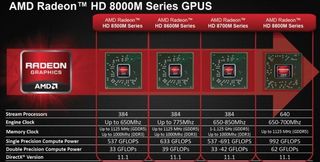AMD announce GCN 2.0 graphics! But don't get too excited just yet...

Yes, that's right AMD's HD 8000 series graphics cards are on their way as we speak - the embargo has lifted and I'm now allowed to tell you that the Graphics Core Next (GCN) 2.0 generation of GPUs is imminent.
But unfortunately they're coming to a laptop probably not very near you first.
This time last year I was all giddy and excited by the first gen GCN cards to arrive in my test rig, the HD 7970 and the HD 7950. Ah, halcyon days. But this year all Santa can bring me from Texas are the mobile spins of AMD's GCN 2.0 architecture.
AMD are touting the first lineups of the HD 8000 series as the HD 8500M, HD 8600M, HD 8700M and HD 8800M. This takes care of the mainstream and low-end enthusiast platforms, with the top-end HD 8900M series looking like it's coming later on next year.
AMD reckons the big thing is the fact that this generation represents the first to have a top-to-bottom lineup of 28nm GCN-based cards. Last year saw anything from the HD 7600M and below being based on the older 40nm tech.
This then is why AMD are calling the HD 8000M series GCN 2.0.
There don't seem to be any architectural changes as far as I can see, and in a briefing call the AMD spokesman explained the '2.0' simply referred to this being the second generation of GPUs to sport the GCN core architecture.
PC Gamer Newsletter
Sign up to get the best content of the week, and great gaming deals, as picked by the editors.

This change though does represent a problem for their Fusion/Trinity laptops.
Traditionally AMD and their partners could pair up the APU with a compatible GPU and go into a sort of hybrid CrossFireX mode. Because of the different GPU architectures in the two chips though they are mutually incompatible in terms of this dual-graphics mode.
We're going to have to wait for the next APU to come along with a GCN GPU integrated into it for that to become a reality. I'm still a little concerned that this Kaveri APU might not even launch in 2013, with rumours being bandied around that this next-gen APU has slipped down the release order.
What the GCN architecture will bring laptop gamers though is a little more battery life for gaming on the go. With the Zero Core technology and the switchable graphics modes of AMD's mobile parts, it can effectively turn the discrete GPU part of the laptop off entirely when it's only using the integrated graphics.
What's more is that the GCN tech has scalable performance when the discrete GPU component is being used. The example given was of a YouTube HD video only needing the GPU to turn on a few of its cores for the given workload, where a 3D game would require all the cores, and a much greater power draw, to run.

Dave has been gaming since the days of Zaxxon and Lady Bug on the Colecovision, and code books for the Commodore Vic 20 (Death Race 2000!). He built his first gaming PC at the tender age of 16, and finally finished bug-fixing the Cyrix-based system around a year later. When he dropped it out of the window. He first started writing for Official PlayStation Magazine and Xbox World many decades ago, then moved onto PC Format full-time, then PC Gamer, TechRadar, and T3 among others. Now he's back, writing about the nightmarish graphics card market, CPUs with more cores than sense, gaming laptops hotter than the sun, and SSDs more capacious than a Cybertruck.
Most Popular

